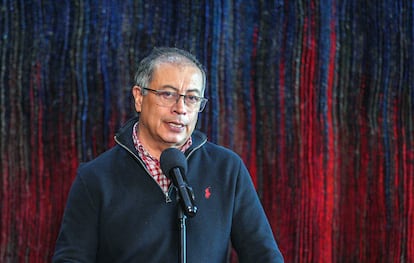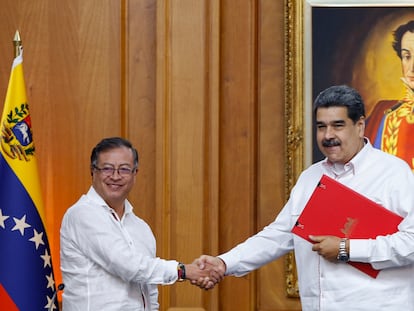The mystery of Gustavo Petro’s cap is solved: The Colombian president shows his hair transplant
Although official sources have made no comment on the matter, experts agree that the Latin American leader has undergone a cosmetic procedure, ending two months of speculation

The mystery of President Gustavo Petro’s cap has been solved. For the first time in two months, the Colombian head of state appeared in public on Tuesday without a head covering. He did so at the inauguration ceremony of Foreign Minister Luis Gilberto Murillo, which he attended wearing a red checkered shirt, a black sweater, but without his by now trademark presidential cap. The president’s head looked different than before he started wearing the cap 24/7. According to what a source close to the presidency told this newspaper and three surgeons concurred with in separate interviews, the explanation is clear: Petro got a hair transplant.
This is what Dr. Mónica Jiménez Baquero believes, after reviewing several official photos of Petro taken this Tuesday. This doctor, who specializes in hair implants and heads the HIC Capilar clinic in Bogotá, is convinced: “It is quite clear that a hair implant was done.” She explains that the president “has a well-defined front line that he didn’t have before.” And she adds that “the shadow of the implant is observed in zone A (frontal region)”: “From what I see, it may have been approximately two months since the hair implant was performed.” According to the expert, during the first few hours after this procedure the patient should use physical means of protection from the sun, such as a cap.
Juliana Sánchez, a surgeon specializing in hair transplants, agrees. “According to the photos, it could be suggestive of a hair transplant,” she maintains. Sánchez says that there are multiple factors that make her think Petro has undergone this procedure. She notes that the president shows a very slight redness on the top of his head, “as if he were healing.” In addition, the hair growth on top “is very different” from that on the back and sides. “This can also happen after a hair transplant,” she explains.
Dr. Lina Triana, who has 20 years of experience in the field, concurs. “I can’t say for sure, but it does seem like something has been done,” she said by phone. Although the three doctors agree, the spokespersons for the Presidency neither confirmed nor denied the treatment. Petro’s press team has not provided a public explanation on the issue, and did not respond to this newspaper’s queries.
But the doctors and the source close to the Presidency are not the first to affirm that there was a hair treatment under the cap. After Petro began to constantly cover his head, questions started to arise. Faced with official silence and the cap as an ever-present element at public appearances, it became a topic of conversation on social media and on the radio. Néstor Morales, the director of the popular radio program Mañanas Blu, raised the possibility of a hair transplant on April 10 and said he had confirmation from Casa de Nariño, the presidential residence and workplace. And the investigative journalist Jorge Espinosa, from Caracol Radio, confirmed the theory that same day. “It’s correct. (…) The issue of the cap and the president has more to do with vanity, to which everyone has the right, than with other issues,” he declared on X, formerly Twitter.
Six weeks later, standing without a cap for official photographs, the mystery is solved: like millions of men do every day, Petro has had a hair transplant. Politicians, after all, are only human.
Sign up for our weekly newsletter to get more English-language news coverage from EL PAÍS USA Edition
Tu suscripción se está usando en otro dispositivo
¿Quieres añadir otro usuario a tu suscripción?
Si continúas leyendo en este dispositivo, no se podrá leer en el otro.
FlechaTu suscripción se está usando en otro dispositivo y solo puedes acceder a EL PAÍS desde un dispositivo a la vez.
Si quieres compartir tu cuenta, cambia tu suscripción a la modalidad Premium, así podrás añadir otro usuario. Cada uno accederá con su propia cuenta de email, lo que os permitirá personalizar vuestra experiencia en EL PAÍS.
¿Tienes una suscripción de empresa? Accede aquí para contratar más cuentas.
En el caso de no saber quién está usando tu cuenta, te recomendamos cambiar tu contraseña aquí.
Si decides continuar compartiendo tu cuenta, este mensaje se mostrará en tu dispositivo y en el de la otra persona que está usando tu cuenta de forma indefinida, afectando a tu experiencia de lectura. Puedes consultar aquí los términos y condiciones de la suscripción digital.
More information
Archived In
Últimas noticias
Iranian women are also defying the taboo of riding motorcycles (and without a license)
David Bowie, the galactic thinker who encouraged us to break new ground
John Berger and the loss of rural culture
From police officer to bloodthirsty kidnapper: Terror in Mexico during the years of ‘The Ear Chopper’
Most viewed
- David King, chemist: ‘There are scientists studying how to cool the planet; nobody should stop these experiments from happening’
- Reinhard Genzel, Nobel laureate in physics: ‘One-minute videos will never give you the truth’
- Oona Chaplin: ‘I told James Cameron that I was living in a treehouse and starting a permaculture project with a friend’
- Mexico completes its trade shift with the entry into force of tariffs on China and countries without trade agreements
- Sinaloa Cartel war is taking its toll on Los Chapitos











































